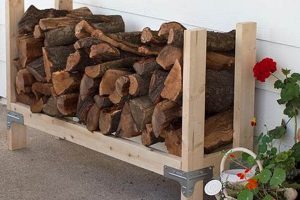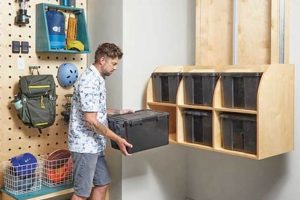A self-constructed seating structure, incorporating internal space for keeping items, exemplifies resourceful space utilization. These projects represent a tangible blend of functionality and personalized design within a living environment. For example, a handcrafted entryway piece provides both a place to sit while removing footwear and a repository for shoes, hats, and other accessories.
The appeal of creating this type of furniture lies in its ability to address specific needs and preferences, offering customization options unavailable in mass-produced items. Historically, built-in benches with storage have been integral parts of homes, maximizing available space and reflecting regional construction styles. The current resurgence in popularity highlights a desire for unique, space-saving solutions and an appreciation for the value of handmade goods.
The subsequent discussion will delve into essential aspects such as material selection, design considerations, construction techniques, and finishing options. These elements are crucial for a successful and enduring outcome, transforming readily available resources into a practical and aesthetically pleasing addition to any home.
Essential Considerations for a Self-Assembled Storage Seating Unit
Constructing a durable and functional storage seating unit necessitates careful planning and precise execution. The following guidelines outline crucial aspects of the process, ensuring a successful outcome.
Tip 1: Material Selection: Prioritize solid hardwoods like oak or maple for load-bearing components. Softwoods, such as pine, may be suitable for less critical sections of the frame or internal storage areas. Consider moisture resistance if the piece is intended for a damp environment, such as a mudroom.
Tip 2: Accurate Measurements: Precise measurements are paramount. Account for the thickness of materials during the design phase. Double-check dimensions before cutting any lumber to avoid costly errors.
Tip 3: Robust Joinery: Employ strong joinery techniques, such as mortise and tenon, dovetails, or pocket screws with wood glue, to ensure structural integrity. Weak joints will compromise the longevity of the structure, particularly under load.
Tip 4: Lid Support Mechanisms: Implement reliable lid support mechanisms, such as torsion hinges or gas struts, for ease of use and safety. These prevent the lid from slamming shut and provide controlled opening and closing.
Tip 5: Adequate Ventilation: If storing potentially moisture-sensitive items, incorporate ventilation holes or gaps in the storage compartment to prevent mildew growth.
Tip 6: Finishing and Protection: Apply a durable finish, such as polyurethane or varnish, to protect the wood from scratches, moisture, and UV damage. Consider the specific environment the seating unit will occupy when selecting the appropriate finish.
Tip 7: Weight Distribution: Design the frame and support structure to evenly distribute weight. Reinforce areas that will bear the brunt of the load, such as the center of the seat.
Adherence to these recommendations will yield a stable, aesthetically pleasing, and long-lasting self-assembled storage seating unit that serves as a valuable addition to the home.
The subsequent sections will elaborate on design aesthetics and customization possibilities, further enhancing the value and personalization of the project.
1. Structural Integrity
Structural integrity constitutes a foundational requirement for any self-assembled storage seating unit. This concept refers to the ability of the construction to withstand applied loads and maintain its intended form and function over time. In the context of furniture, insufficient structural integrity leads to premature failure, manifested as wobbling, sagging, or complete collapse. For example, a seating unit constructed with inadequately sized frame members or weak joinery will likely fail under the weight of a seated individual, rendering it unusable and potentially hazardous.
The selection of appropriate materials directly influences structural integrity. Solid hardwoods, such as oak or maple, generally offer superior strength and resistance to deformation compared to softwoods like pine. The choice of joinery techniques also plays a critical role. Mortise and tenon joints, dovetail joints, and properly executed screw connections with adhesive provide significantly stronger bonds than simple butt joints or nails. Furthermore, the design must account for load distribution. Reinforcing areas subject to high stress, such as the center of the seat or around leg attachments, is crucial for preventing localized failure. A well-designed frame, coupled with robust joinery and appropriate material selection, ensures that the unit can bear the intended weight without compromising its structural stability.
Ultimately, prioritizing structural integrity in the design and construction phases is paramount for creating a safe and durable self-assembled storage seating unit. Ignoring this aspect results in a compromised product with limited lifespan and potential safety risks. A thorough understanding of load-bearing principles, material properties, and appropriate joinery techniques is, therefore, essential for successful project completion.
2. Material Durability
Material durability directly correlates with the longevity and functionality of a self-assembled storage seating unit. The ability of chosen materials to withstand wear, environmental factors, and applied stress dictates the unit’s lifespan and its capacity to fulfill its dual purpose: seating and storage. An unsuitable selection can lead to premature degradation, structural instability, and compromised usability. For instance, utilizing untreated softwood in a high-humidity environment risks rot and decay, jeopardizing the structural integrity of both the seating surface and the storage compartment.
The choice of material impacts resistance to scratches, dents, and stains, particularly critical for seating surfaces subject to frequent use. Hardwoods, such as oak or maple, offer superior durability in these areas compared to softer options like pine or particleboard. Furthermore, the selected material affects the unit’s ability to support weight. Inferior materials may buckle or deform under load, rendering the seating function unsafe or unusable. Consider a scenario where a storage seating unit intended for entryway use, constructed from low-density fiberboard, collapses under the weight of an adult, creating a safety hazard and negating the intended functionality.
In conclusion, material durability is a non-negotiable aspect of a successful self-assembled storage seating unit. Prioritizing durable materials ensures a longer lifespan, enhances safety, and contributes to a more aesthetically pleasing and functional piece of furniture. Understanding the properties of different materials and their suitability for various applications within the construction process is therefore paramount.
3. Ergonomic Design
Ergonomic design, when applied to a self-assembled storage seating unit, directly influences user comfort, posture, and overall well-being. The correlation between these elements is a critical determinant of the unit’s practical value and long-term usability. Neglecting ergonomic principles results in a seating structure that may be aesthetically pleasing but ultimately detrimental to physical health. For example, a bench seat with insufficient depth forces occupants to sit with inadequate thigh support, leading to discomfort and potential back strain. The height of the seat also significantly impacts leg posture and ease of ingress and egress; a height that is too low can strain knees, while a height that is too high compromises foot contact with the floor, destabilizing posture. The cause-and-effect relationship is clear: poor ergonomic design causes discomfort and potential physical harm; appropriate ergonomic design promotes comfort and supports healthy posture.
The integration of ergonomic considerations extends beyond basic dimensions. The angle of the backrest, if present, must provide adequate lumbar support. The inclusion of armrests can alleviate shoulder and neck strain, especially during extended periods of sitting. The choice of seat cushioning material also contributes to ergonomic comfort; a material that is too firm offers insufficient pressure relief, while a material that is too soft lacks adequate support, potentially leading to postural instability. A practical application involves designing a mudroom storage bench seat with a slightly angled backrest, lumbar support, and a seat height that accommodates users of varying heights. This design prioritizes comfort and reduces the likelihood of physical discomfort associated with prolonged sitting.
In summary, ergonomic design is not a secondary consideration but an integral component of a successful self-assembled storage seating unit. Prioritizing user comfort, posture, and physical well-being through thoughtful design choices translates to a more functional, enjoyable, and ultimately more valuable piece of furniture. Challenges include accurately assessing the ergonomic needs of potential users and balancing these needs with aesthetic and structural requirements. However, the benefits of incorporating ergonomic principles far outweigh the challenges, resulting in a seating unit that promotes both physical health and aesthetic appeal.
4. Storage Accessibility
Storage accessibility represents a critical design consideration for a self-assembled storage seating unit. The ease with which the internal storage compartment can be accessed directly impacts the functionality and convenience of the unit, influencing its overall utility and user satisfaction.
- Lid Opening Mechanisms
The type of lid opening mechanism significantly affects storage accessibility. Hinged lids require sufficient clearance space for full opening. Lift-off lids offer unrestricted access but require a designated placement area when removed. Sliding doors or drawers offer access without needing extra clearance, but reduce the size of the items can be stored. The chosen mechanism should align with the intended storage items and spatial constraints.
- Internal Compartment Organization
The internal organization of the storage compartment impacts the efficiency of item retrieval. A single, undivided space may be suitable for large, bulky items, while divided compartments or removable trays facilitate organized storage and easier access to smaller items. Modular configurations offer customizable organization to accommodate diverse storage needs.
- Lid Weight and Support
The weight of the lid and the presence of supporting mechanisms influence the ease of opening and closing the storage compartment. Heavy lids without adequate support can pose a safety hazard and hinder accessibility. Gas struts or spring-loaded hinges provide controlled opening and closing, enhancing both safety and convenience.
- Reach and Clearance
The depth and height of the storage compartment, combined with the seating unit’s overall dimensions, affect the user’s reach and clearance during item retrieval. A deep compartment may require bending or kneeling to access items at the bottom, potentially limiting accessibility for individuals with mobility constraints. Careful consideration of these factors is essential for promoting universal accessibility.
Effective storage accessibility transforms a self-assembled seating unit from a simple piece of furniture into a functional and convenient storage solution. By addressing the above facets during the design and construction process, one can maximize the utility and usability of a storage seating unit, enhancing its value and contributing to a more organized living space.
5. Aesthetic Harmony
Aesthetic harmony, in the context of a self-assembled storage seating unit, denotes the congruity between the unit’s visual characteristics and the existing interior design of the space it occupies. A lack of aesthetic harmony can result in a visually jarring element, detracting from the overall appeal of the room. The color, style, and materials of the seating unit must complement the surrounding furniture, wall colors, and architectural features to create a cohesive and visually pleasing environment. For example, a rustic-style bench constructed from reclaimed wood may appear incongruous within a modern, minimalist living room characterized by sleek lines and neutral colors. This disconnect compromises the intended aesthetic and diminishes the unit’s value as a design element.
Conversely, a well-integrated seating unit enhances the overall aesthetic of the space. A carefully chosen paint color that matches existing trim, or the use of upholstery fabric that complements the room’s color palette, creates a sense of visual unity. The style of the unit whether traditional, contemporary, or eclectic should align with the predominant design theme. Furthermore, details such as hardware selection (knobs, hinges) and the design of any visible legs or supports contribute to the overall aesthetic effect. Practical application involves carefully considering the existing design elements when selecting materials, finishes, and design plans. Before beginning construction, it is advantageous to create a digital rendering or a physical mock-up to visualize how the unit will integrate into the space, ensuring aesthetic compatibility.
In summary, achieving aesthetic harmony is crucial for transforming a functional self-assembled storage seating unit into a visually appealing addition to the home. It ensures that the unit complements the existing decor and contributes to a cohesive and aesthetically pleasing living environment. Failure to consider aesthetic harmony can result in a design element that clashes with its surroundings, diminishing the room’s overall appeal and detracting from the user’s experience. The challenge lies in balancing personal design preferences with the existing aesthetic framework of the space to create a visually unified and harmonious outcome.
Frequently Asked Questions
This section addresses common inquiries and misconceptions regarding the design and construction of storage seating units intended for do-it-yourself assembly. The information presented aims to clarify key considerations and provide guidance for successful project completion.
Question 1: What is the minimum skill level required to construct a functional storage seating unit?
A basic understanding of woodworking techniques, including measuring, cutting, joining, and finishing, is generally required. Familiarity with power tools, such as saws, drills, and sanders, is also recommended. Projects can be adapted to varying skill levels by simplifying designs and utilizing readily available pre-cut lumber.
Question 2: What are the most common mistakes encountered during the assembly process?
Frequently observed errors include inaccurate measurements, improper joinery techniques, inadequate support structures, and neglecting to account for lid weight and balance. Careful planning, precise execution, and thorough inspection of each step are crucial for mitigating these risks.
Question 3: How can the safety of a self-assembled storage seating unit be ensured?
Prioritize structural integrity by using durable materials and robust joinery techniques. Implement lid support mechanisms to prevent accidental closures. Ensure proper weight distribution and reinforcement of load-bearing areas. Inspect the unit regularly for signs of wear or damage, and promptly address any issues.
Question 4: What type of wood is best suited for constructing a durable storage seating unit?
Hardwoods such as oak, maple, and cherry offer superior strength and resistance to wear compared to softwoods like pine. However, softwoods may be appropriate for non-load-bearing components or internal storage areas. Consider moisture resistance if the unit is intended for use in a damp environment.
Question 5: What are the key considerations for selecting appropriate hardware for a storage seating unit?
Hinges, lid supports, and fasteners should be selected based on their load-bearing capacity, durability, and compatibility with the chosen materials. Corrosion-resistant hardware is recommended for units exposed to moisture. Ensure that all hardware is securely fastened and properly aligned for optimal functionality.
Question 6: What are the recommended finishing techniques for protecting a storage seating unit?
Applying a durable finish, such as polyurethane, varnish, or paint, protects the wood from scratches, moisture, and UV damage. Prepare the surface properly by sanding and priming before applying the finish. Multiple coats are generally recommended for optimal protection and aesthetic appeal. Consider the specific environment the seating unit will occupy when selecting the appropriate finish.
Addressing these frequent inquiries provides a foundation for informed decision-making and successful execution of self-assembled storage seating unit projects. Diligent planning, attention to detail, and adherence to sound construction principles will contribute to a safe, functional, and aesthetically pleasing outcome.
The subsequent section will present detailed construction plans for a sample storage seating unit, providing a practical guide for implementing the principles discussed herein.
DIY Storage Bench Seat
This exposition has detailed the multifaceted aspects of the diy storage bench seat, ranging from material selection and structural integrity to ergonomic design and aesthetic harmony. The comprehensive understanding of these elements is paramount for successful project completion and the creation of a functional, durable, and visually appealing piece of furniture.
The diy storage bench seat represents more than a mere construction project; it embodies a commitment to resourcefulness, customization, and the integration of practical solutions within a living space. Continued innovation in design and construction techniques ensures the ongoing relevance and adaptability of this versatile furniture piece. Its enduring appeal lies in its ability to address individual needs and reflect personal aesthetics, solidifying its position as a valuable addition to the modern home.







